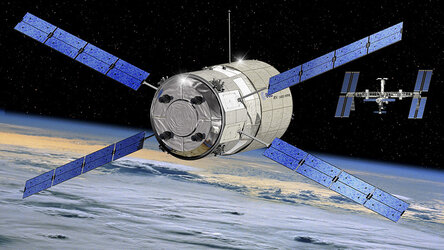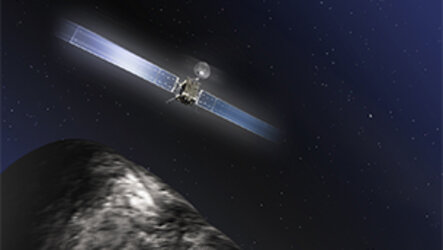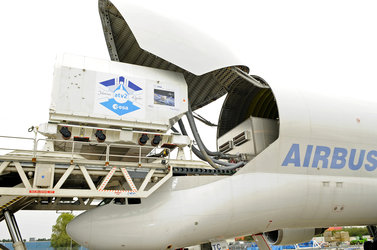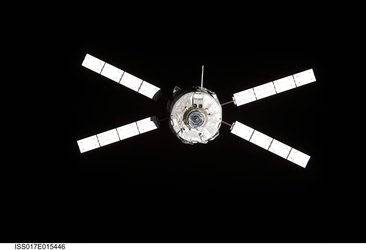ATV Jules Verne operations team wins prestigious UK aeronautics prize
The UK's Royal Aeronautical Society has awarded its top Gold Medal Team prize to ESA's Automated Transfer Vehicle operations team, in recognition of their achievement in operating ATV Jules Verne during its 2008 mission to the International Space Station.
The Gold Medal is conferred for work of outstanding achievement in aerospace.
ATV Jules Verne, ESA's first resupply and reboost vehicle, was launched in March 2008 and on 3 April became the first vessel to perform a fully automated docking with the International Space Station (ISS). During the vessel's five-month attached phase, Jules Verne delivered over 2200 kg of vital cargo, including food, clothes, equipment, fuel, water and oxygen, to the astronauts on the ISS.
The extremely accurate automated docking demonstrated Europe's world-class industrial capabilities and the superlative skill of the scientists, engineers and technicians who contributed to the construction, preparation, launch and operation.

"I am delighted to accept this award on behalf of the Agency and everyone across borders and organisations who worked long and hard to make ATV an outstanding success. The ATV's design and construction, the superb automated docking technology and her flawless first mission all tell a truly European success story," said Bob Chesson, Head of ESA's Human Spaceflight Operations Department.
In flight, ATV operations are managed by a combined ESA/CNES (Centre National d'Études Spatiales) mission operations team based at ESA’s ATV Control Centre, Toulouse, France. These experts are assisted by a network of support teams from ESA's Human Spaceflight, Operations and Technology Directorates, at CNES, and at dozens of industrial partner companies from 10 European countries under the prime contractorship of EADS Space Transportation, France.

"I am particularly happy to see that this is the Royal Aeronautical Society's 'team' award, attesting to the excellent team work demonstrated over many years, culminating in the completion of an outstanding ATV mission," said Alberto Novelli, ESA's ATV Mission Director based at the ATV Control Centre.
Both Chesson and Novelli were present at the RAeS 2009 Medals & Awards gala ceremony in London to accept the Gold Medal Team prize, which was jointly awarded to the Vectored-thrust Aircraft Advanced Control Harrier Team, QinetiQ, UK.
In 2008, Jules Verne carried into orbit two original manuscripts handwritten by French author Jules Verne and a XIXth century illustrated edition of his novel, From the Earth to the Moon.
The vessel was launched on 9 March 2008, from the Guiana Space Centre, Europe's Spaceport in Kourou, French Guiana, on an Ariane 5ES, a version specifically adapted to carry ATV-s almost 20-tonne loaded weight. After a flawless five-month mission, ATV undocked from the ISS on 5 September, and conducted a preplanned destructive reentry into Earth’s atmosphere on 29 September.
ATV Jules Verne milestones
1998 - ATV development starts
2002 - ATV dubbed "Jules Verne"
2007 - Jules Verne shipped to Kourou
2008 - ATV launch via Ariane 5, 9 March
2008 - Automated docking to the ISS, 3 April
2008 - ATV performs first Station reboost manoeuvre, 25 April
2008 - Undocking, 5 September
2008 - Reentry, 29 September
About the Royal Aeronautical Society
The Royal Aeronautical Society, based in London, is the world's only professional body dedicated to the entire aerospace community. Established in 1866 to further the art, science and engineering of aeronautics, the Society has been at the forefront of developments in aerospace ever since.
The Society promotes the highest professional standards in all aerospace disciplines and is a key provider of specialist information on aspects of aerospace. In addition, the Society acts as a central forum for the exchange of ideas and plays a leading role in influencing opinion on aerospace matters. There are over 17 000 members in more than 100 countries. Every year the Society holds over 400 conferences, lectures and events.
The Society's first Gold Medal was awarded in 1909 to Wilbur and Orville Wright, the first aviators to fly, and past winners include some of the most famous names in aviation history.















 Germany
Germany
 Austria
Austria
 Belgium
Belgium
 Denmark
Denmark
 Spain
Spain
 Estonia
Estonia
 Finland
Finland
 France
France
 Greece
Greece
 Hungary
Hungary
 Ireland
Ireland
 Italy
Italy
 Luxembourg
Luxembourg
 Norway
Norway
 The Netherlands
The Netherlands
 Poland
Poland
 Portugal
Portugal
 Czechia
Czechia
 Romania
Romania
 United Kingdom
United Kingdom
 Slovenia
Slovenia
 Sweden
Sweden
 Switzerland
Switzerland
































